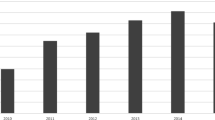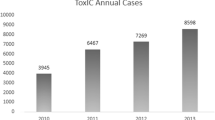Abstract
Introduction
Synthetic cannabinoid (SC) abuse has resulted in numerous outbreaks of severe clinical illness across the United States over the past decade. The primary objective of this study was to determine the clinical characteristics of patients abusing SC requiring bedside consultation by medical toxicologists.
Methods
This was a multicenter analysis from a prospectively collected cohort of patients presenting to medical care after synthetic cannabinoid exposure, utilizing the ToxIC Registry. Management of cases by medical toxicologists in this cohort occurred in emergency departments, inpatient medical floors, and intensive care units. Cases were identified from January 5, 2010 – July 31, 2015. We characterized the clinical presentations, treatments, outcomes, and sociologic factors associated with SC use in these patients.
Results
Medical toxicologists participating in the ToxIC Registry cared for 39,925 cases between 2010 and 2015. Three hundred fifty three of these cases were determined to be SC toxicity. The median age of patients was 25 (IQR: 18, 36) and the majority were males (84%). The most common symptoms were agitation, delirium and toxic psychosis, n=146 (41%). Forty-four (12.5%) had heart rates above 140 beats per minute. Bradycardia was the second most commonly reported severe vital sign abnormality with 20 (5.7%) having heart rates of less than 50 beats per minute. Fifteen (4.2%) patients had hypotension. Fifty-nine (17%) had seizures. The most common pharmacologic treatment provided was benzodiazepines (n=131, 37%) followed by antipsychotics (n=36, 10%).Disposition was available for 276; of these 167 (61%) were managed in the emergency department, 42 (15%) were admitted to the hospital floor, and 67 (24%) were admitted to the ICU.
Conclusions
Synthetic cannabinoids are associated with severe central nervous system and cardiovascular effects.


Similar content being viewed by others
References
Castaneto MS, Gorelick DA, Desrosiers NA, et al. Synthetic cannabinoids: epidemiology, pharmacodynamics, and clinical implications. Drug Alcohol Depend. 2014;144:12–41.
Loeffler G, Hurst D, Penn A, et al. Spice, bath salts, and the U.S. military: the emergence of synthetic cannabinoid receptor agonists and cathinones in the US Armed Forces. Mil Med. 2012;177(9):1041–8.
Patrick ME, O’Malley PM, Kloska DD, et al. Novel psychoactive substance use by US adolescents: Characteristics associated with use of synthetic cannabinoids and synthetic cathinones. Drug Alcohol Rev. 2015.
Trecki J, Gerona RR, Schwartz MD. Synthetic cannabinoid–related illnesses and deaths. NEJM. 2015;373(2):103–7.
Castaneto MS, Wohlfarth A, Desrosiers NA, et al. Synthetic cannabinoids pharmacokinetics and detection methods in biological matrices. Drug metabolism reviews. 2015; 1–51.
Banister SD, Moir M, Stuart J, et al. Pharmacology of indole and indazole synthetic cannabinoid designer drugs AB-FUBINACA, ADB-FUBINACA, AB-PINACA, ADB-PINACA, 5F-AB-PINACA, 5F-ADB-PINACA, ADBICA, and 5F-ADBICA. ACS Chem Neurosci. 2015;6(9):1546–59.
Monte AA, Bronstein AC, Cao DJ, et al. An outbreak of exposure to a novel synthetic cannabinoid. N Engl J Med. 2014;370(4):389–90.
Young AC, Schwarz E, Medina G, et al. Cardiotoxicity associated with the synthetic cannabinoid, K9, with laboratory confirmation. Am J Emerg Med. 2012;30(7):1320.e1325–7.
Adams AJ, Banister SD, Irizarry L, et al. “Zombie” outbreak caused by the synthetic cannabinoid AMB-FUBINACA in New York. N Engl J Med. 2016.
Thomas A, Baillie GL, Phillips AM, et al. Cannabidiol displays unexpectedly high potency as an antagonist of CB1 and CB2 receptor agonists in vitro. Br J Pharmacol. 2007;150(5):613–23.
Laprairie RB, Bagher AM, Kelly ME, et al. Cannabidiol is a negative allosteric modulator of the cannabinoid CB1 receptor. Br J Pharmacol. 2015;172(20):4790–805.
Cottencin O, Rolland B, Karila L. New designer drugs (synthetic cannabinoids and synthetic cathinones): review of literature. Curr Pharm Des. 2013.
Banister SD, Stuart J, Kevin RC, et al. Effects of bioisosteric fluorine in synthetic cannabinoid designer drugs JWH-018, AM-2201, UR-144, XLR-11, PB-22, 5F-PB-22, APICA, and STS-135. ACS Chem Neurosci. 2015;6(8):1445–58.
Hoyte CO, Jacob J, Monte AA, et al. A characterization of synthetic cannabinoid exposures reported to the National Poison Data System in 2010. Ann Emerg Med. 2012;60(4):435–8.
Bernson-Leung ME, Leung LY, Kumar S. Synthetic cannabis and acute ischemic stroke. J Stroke Cerebrovasc Dis. 2013.
Mir A, Obafemi A, Young A, et al. Myocardial infarction associated with use of the synthetic cannabinoid K2. Pediatrics. 2011;128(6):e1622–7.
Wax PM, Kleinschmidt KC, Brent J, et al. The toxicology investigators consortium (ToxIC) registry. J Med Toxicol. 2011;7(4):259–65.
Adair EB, Craddock SG, Miller HG, et al. Assessing consistency of responses to questions on cocaine use. Addiction. 1995;90(11):1497–502.
Darke S. Self-report among injecting drug users: a review. Drug Alcohol Depend. 1998;51(3):253–63. discussion 267-258
Passik SD, Hays L, Eisner N, et al. Psychiatric and pain characteristics of prescription drug abusers entering drug rehabilitation. J Pain Palliat Care Pharmacother. 2006;20(2):5–13.
Harris CR, Brown A. Synthetic cannabinoid intoxication: a case series and review. J Emerg Med. 2013;44(2):360–6.
Author information
Authors and Affiliations
Consortia
Corresponding author
Ethics declarations
Conflict of Interest
The contents of this work are the sole responsibility of the authors and do not necessarily represents the views of the National Institutes of Health (NIH). The authors declare that they have no conflict of interest.
Funding and Financial Disclosures
Dr. Monte receives support from NIH 1 K23 GM110516 and NIH CTSI UL1 TR001082. Dr. Monte has a patent pending for a synthetic cannabinoid clinical assay and has been awarded funding through the Department of Defense for examination of patterns of use of synthetic cannabinoids and assay development. A subset of the data collected was funded by the grant NIH R56 DA038366 (Carlson, Sheth, Boyer, PIs).
Rights and permissions
About this article
Cite this article
Monte, A.A., Calello, D.P., Gerona, R.R. et al. Characteristics and Treatment of Patients with Clinical Illness Due to Synthetic Cannabinoid Inhalation Reported by Medical Toxicologists: A ToxIC Database Study. J. Med. Toxicol. 13, 146–152 (2017). https://doi.org/10.1007/s13181-017-0605-9
Received:
Revised:
Accepted:
Published:
Issue Date:
DOI: https://doi.org/10.1007/s13181-017-0605-9




